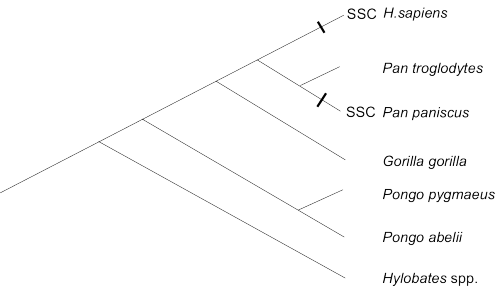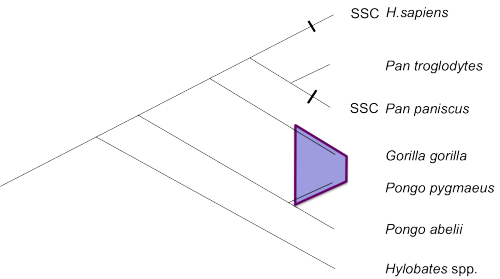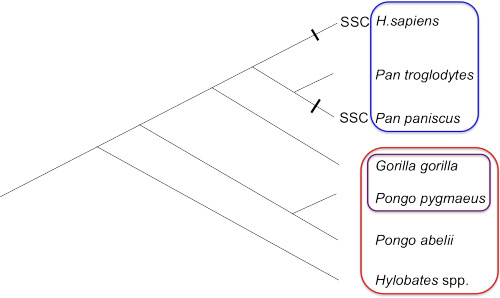
Taxon structure

What
kind of taxon (mono-, para-, or polyphyletic) would be created by joining the two species that share the trait
"SSC" in the tree above? Before we consider this question, let us examine various ways of dealing with the problem.
The most widespread view,
almost always given in textbooks and strongly advocated by Wiley and
others disciples of Hennig, is whether or not a taxon contains (1) the
most recent common ancestor
itself and (2) all its descendents.

In the example above, a taxon that includes humans, chimps, and bonobos
is monophyletic because it meets both criteria. On the other
hand, a taxon that would include gorillas, orangutans, and gibbons
would only fulfill the first criterion, inclusion of the common
ancestor, but not the second, as some descendents (Homo and Pan) are excluded, and thus would be regarded as paraphyletic.

Last, a taxon that includes only gorillas and the Bornean orangutan
fulfills neither criterion as it does not include the common ancestor to
the two species and is therefore considered polyphyletic.
Easy enough, and in a conceptual context, these definitions of mono-,
para-, and polyphyly are clear and straightforward. The problem
arises when one leaves the Platonic world of concepts and instead
attempts to deal with the practical
reality of systematics. The many advocates of the ancestor
membership criterion nearly always fail to mention the small but
non-trivial detail that common ancestors are in practice never
available. Even the most recent common ancestors in our ape tree,
those of the two Pan species or those of the two Pongo
species, are extinct and may not have left any fossils; even if
fossils do exist, there is no way to demonstrate that a given fossil
truly represents the ancestor of a particular extant species. Lenski's frozen bacteria or Hillis's frozen bacteriophage
are rare exceptions where the common ancestor of a population (not a
collection of species) is known and available; but such situations are
not expected to occur in the natural world.
In other words, a
definition of taxon structure that involves membership of ancestor
species is completely unworkable in real biology. Practising systematists must use a different approach based on set structure.

Inferred phylogenies impose
onto taxa a nested set structure, based on presumed ancestry.
Members of nested sets constitute a clade. Taxa that belong to an incomplete nested set form a grade.
This ontology is entirely consistent with that proposed by
Hennig. For some unknown reason, he added the stipulation that
taxa must include the common ancestor. It is possible that Hennig's thought was distorted by translation and that he meant something else (share a common ancestor?). This said, E.O. Wiley and many other theorists continue explicitly and emphatically to
perpetuate this idea, which, if adhered to, would effectively seem to
preclude the description of most taxa above the species level.
Summing up:
- A taxon that includes all members of a nested set (clade) is monophyletic.
- A grade, or taxon whose members are nearest neighbours but from which a nested set is missing, is a
paraphyletic taxon.
- A taxon that consists of members of two or more incomplete sets is polyphyletic.
Hennig also used character mapping as a means of defining taxa in terms of phylogenetic structure.
A taxon that is defined by a ___
___ synapomorphy is monophyletic;
___ sympleisomorphy is paraphyletic;
___ homoplasy is polyphyletic.
But things are never simple. In our ape example, one might argue
that SSC-positive species acquired
this trait independently, in which case a taxon defined on the basis of
SSC would be polyphyletic. However, topologically, the two
SSC-positive species form a paraphyletic taxon because they share a
recent common ancestor but exclude one of its descents. This
would receive further support if one had evidence that SSC was present
in the common ancestor but was subsequently lost in the lineage that
led to chimps. So, nothing is black-and-white... Likewise,
there is no reason why we should not include, in our polyphyletic taxon
that contains gorilla and Bornean orangutan, their common ancestor.
Note that the current taxonomy of taxon structure has
never been universally accepted and is still the object of some
contention. Some authors have argued that paraphyletic taxa do
share a single evolutionary origin and so should be regarded as a kind
of monophyletic taxa. The term holophyletic would then
distinguish complete sets (clades) from incomplete sets (grades).
For further discussion of these matters, see Envall (2008).
Return to